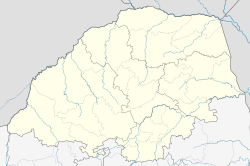Mahwelereng
| Mahwelereng | |
|---|---|
|
|
|
| Coordinates: 24°09′S 28°59′E / 24.150°S 28.983°ECoordinates: 24°09′S 28°59′E / 24.150°S 28.983°E | |
| Country | South Africa |
| Province | Limpopo |
| District | Waterberg |
| Municipality | Mogalakwena |
| Area | |
| • Total | 11.55 km2 (4.46 sq mi) |
| Population (2011) | |
| • Total | 41,072 |
| • Density | 3,600/km2 (9,200/sq mi) |
| Racial makeup (2011) | |
| • Black African | 99.4% |
| • Coloured | 0.1% |
| • Indian/Asian | 0.1% |
| • White | 0.1% |
| • Other | 0.3% |
| First languages (2011) | |
| • Northern Sotho | 75.7% |
| • Tsonga | 6.7% |
| • S. Ndebele | 6.1% |
| • Sotho | 3.7% |
| • Other | 7.8% |
| Postal code (street) | 0626 |
| PO box | 0626 |
| Area code | 015 |
Mahwelereng is a township in the Mogalakwena Local Municipality of the Waterberg District Municipality of the Limpopo Province of South Africa. It is about 2 km from Mokopane. The township is a product of Apartheid South Africa's policies in the former Bantustan of Lebowa. Most of the original residents of Mahwelereng were from an area which old residents call "Ol' Location". Ol' Location was too close to town and the residents had to be moved further away from town. There are still remnants of Ol' Location such as the "Bar" and the Lutheran Church Mission on the Sekgakgapeng site. The township is bordered by Sekgakgapeng, Ga-Michele, Moshate and Madiba.
The township grew rapidly as a result of urbanisation, as it afforded job opportunities in an area largely surrounded by rural settlements. The lack of affordable housing stock has also led to an increase in informal housing. The name Mahwelereng (meaning place of Mohwelere trees) is derived from the name of a tree referred to in the Northern Sotho language as Mohwelere.
It was a well-planned township with a sound infrastructure. The water drainage system was comparable to that of most towns, and there are lights on every street. However, the township lacks tarred roads and a reliable electricity supply. Roads are maintained with gravel mined locally next to the current Mahwelereng Stadium, known as "Lekgethe".
The original housing units comprised two-, four- and five-room houses and a few seven-room houses. These sections gave rise to the names for these particular areas. The "Di-Five" area has larger houses reserved for high-ranking government employees. Most of these five-room houses had 2 bedrooms, a lounge/dining room, a kitchen, and a toilet. Over time, however, some of the original houses were demolished by the owners to make room for larger homes; this was most often done by government employees who received housing subsidies. The "Di-Four" area has predominantly four-room houses, which included two bedrooms, a lounge/dining room, a kitchen and a toilet on the outside; some were flush toilets and some were not. The "Di-Two" area has a mix of four-room houses and two-room houses. The two-room houses had one bedroom and one kitchen-cum-lounge-cum-bedroom, with a non-flush toilet on the outside. Di-Two had a notorious section called Phadima Section.
...
Wikipedia



